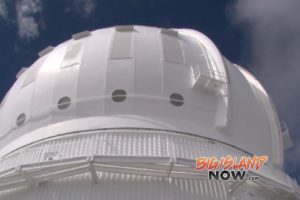New Instrument to Search for Habitable Planets
A team of astronomers and engineers are waiting for the most important delivery of the decade at Canada-France-Hawai‘i Telescope (CFHT), in a small window between the snow flurries atop Maunakea. SPIRou, the observatory’s newest and most advanced instrument, arrived at noon to begin preparations to find new habitable planets outside of our solar system.

The Canada-France-Hawaii Telescope welcomed SPIRou, the next generation of advanced instrumentation for the world’s leading collection of observatories atop Maunakea.
The Maunakea Observatories instrumentation programs are the key to the telescopes’ continued ranking as the most scientifically productive in the world. Each instrument can be fitted onto the telescopes of their respective observatories to give scientists new, advanced capabilities for a highly specialized research. SPIRou (SpectroPolarimetre Infra-Rouge) belongs to the next generation of astronomy instruments with the goal to find Earth- like planets in the habitable zones of nearby red-dwarf stars. It is capable of detecting the tiny wiggle in a star, which indicates the presence of planets.
“SPIRou is a giant leap forward for the search for planets” says astronomer and SPIRou instrument scientist at CFHT Claire Moutou. “With its high precision and ability to look at infrared light, we will discover planets that were undiscoverable before. It’s very exciting.”
Along with professional astronomers, dozens of Hawai‘i State Department of Education high school students are anticipating the chance to use SPIRou through the observatories’ Maunakea Scholars program, which gives observing time and mentorship to students statewide.
SPIRou looks at the rainbow or spectra of nearby red-dwarf stars. These red dwarfs are very cool, roughly the temperature of a halogen bulb. To measure the spectra of the stars, SPIRou operates in the infrared, wavelengths of light longer than the red light humans can see with their eyes. As the planet orbits its star, the gravity of the planet pulls the star ever so slightly. SPIRou will detect these wiggles in a star that is being moved at a speed of 2.25 miles per hours by its orbiting planets.
“The cameras on SPIRou are cutting edge technology” say project engineer for SPIRou at CFHT Greg Barrick. “No one else on Earth right now has cameras that can make these measurements.”
After its arrival at the summit, SPIRou will be unpacked and reassembled, a delicate process that will take a couple of months. Once it is reassembled, the instrument will undergo testing in the lab and on the sky before being declared ready for science. CFHT anticipates SPIRou capturing its first light in spring 2018.













